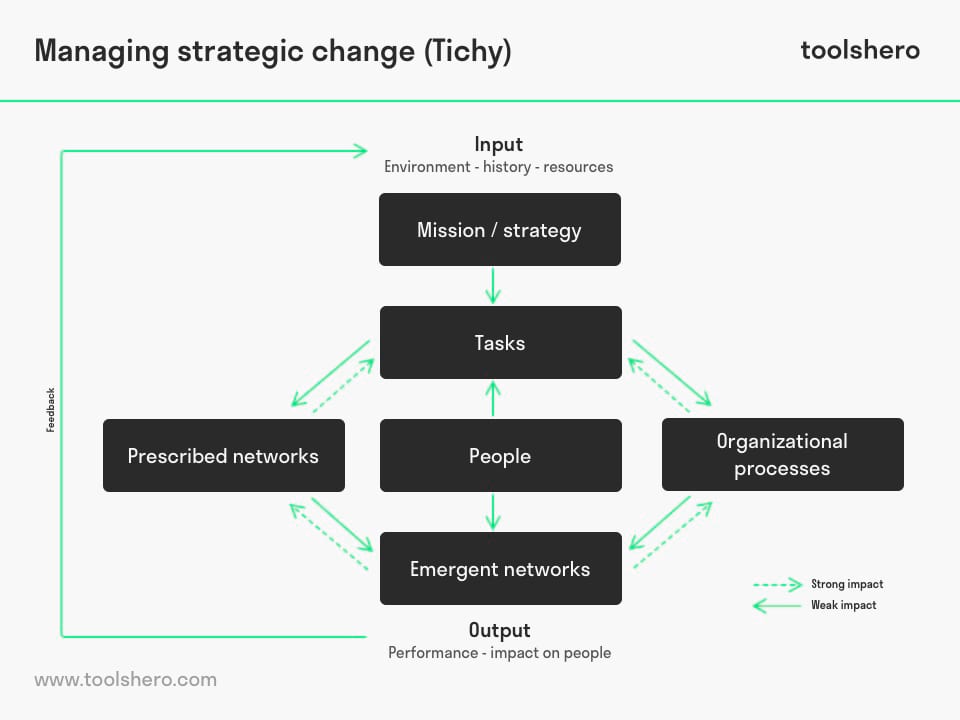Managing Strategic Change by Noel M. Tichy

Managing Strategic Change: this article offers a practical explanation of managing strategic change by Noel M. Tichy. Next to what this theory is, this article highlights the framework, the practice of managing Strategic Change and a final word (summary). Enjoy reading!
What is Managing Strategic Change?
Strategic change is concerned with critical implementations for businesses that are with the intent to attempt to enhance their competitiveness in the marketplace.
It can be seen as long-term projection decisions that are be evaluated critically. Therefore, strategic change deals with researching different internal and external factors carefully to make the right decisions.
Managing Strategic Change occurs during the implementation of the change. Noel M. Tichy, an American management consultant, educator, and author of many books, authored ‘Managing Strategic Change’.
In this book, Tichy refers to Managing Strategic Change by implementing the TPC framework. TPC stands for technical, political, and cultural dynamics.
Tichy, the originator of the TPC framework, argues that businesses need to analyze the previously mentioned dynamics if organizations want to manage strategic change. As a result of the evaluation of the technical, political, and cultural dynamics of an organization, the chance is high that firms are able to answer strategic change-related questions such as questions related to the industry the business operates in and employee values.
Managing Strategic Change is, in general, concerned with identifying organizational problems and challenges and identifying how these can be influenced so that it benefits the firm in the future. The dynamics identified by Tichy are interrelated, which are in the next section explained more in detail.
TPC framework of Managing Strategic Change
As previously explained, handling strategic change can be succeeded with integrating technical, political, and cultural dynamics.

Figure 1 – Managing Strategic Change model (Tichy)
Technical dynamics
This dynamic of Managing Strategic Change is concerned with the organizational structure and problems with the product portfolio. For example, due to increased global competition, it has become easier for businesses to learn and copy from innovations. The result of global learning increases the demand for qualitative and competitively priced products.
Companies that fail to keep up with the developments in the industry need to recognize the need for change. Next to solely product-related aspects, the technical dynamic of Managing Strategic Change is also concerned with various organizational strategies. For example, after an internal profitability evaluation, a company could identify that focusing on a specific target group is not profitable. It could serve as an indicator to change the company’s strategic direction.
Political dynamics
The political dynamic is an essential factor to evaluate. From a company perspective, it is the application of resources to influence current and future political decisions. Moreover, the political element is important because it is many times deals with pressures that are related to macro perspective problems.
Cultural dynamics
The cultural factor is, in general, concerned with norms and values that are not yet discussed in the organization internally. Another view of cultural dynamics is viewing the factor as external pressures for change due to different or changing values and beliefs of society. For example, these external pressures for change could be related to equal opportunities for labor that typically should result in a more diversified labor force.
According to Tichy, although the technical, political, and cultural dynamics are separate factors to evaluate, the dynamics are able to influence another. From a company perspective, firms should assess which element of the TPC framework visualize the most significant development.
The dynamic with the most development could be a trigger for change. However, it is easier said than done because all dynamics also bring much uncertainty in terms of how a factor might develop over time.
Firms should evaluate and reevaluate the technical, political, and cultural dynamics continuously because these represent the context from which the organization could change its direction and prioritize work.
Altogether, the dynamics represent problems that will come and go. Solving these problems might be unrealistic, but firms can deal with these dynamics on an ongoing basis.
Managing Strategic Change
In order to Managing Strategic Change, it is first essential to understand an organizational structure. Tichy refers to an organization as an organization that consists of social objects.
The social objects are the employees of an organization who interact with each other and who do the following: the employees integrate different technical, pollical, and cultural approaches, the employees focus on useful challenging questions, and the employees help to implement change.
The employees are therefore interconnected, and the employees play a critical role in managing strategic change because the workforce enables the flow of goods and services, and they share knowledge.
Using the TPC framework can be useful to identify the need for change, but it is also helpful for managing strategic change. The TPC framework can be used in combination with a network model, a model. Tichy’s network model comprises the following elements: input, mission and vision, tasks, formal network, organizational processes, informal networks, and output. All are briefly explained below.
Input
For Managing Strategic Change, it is crucial to understand the history of the organization. Therefore, the input is concerned with how the business has developed over time. It refers to all inputs provided by the firm that helped to build a firm’s reputation. It is essential because the history of a business determines, for a large part, the future direction of the company.
Mission and vision
Managing Strategic Change can only be successful if the company succeeds in communicating corporate messages consistently.
Since the mission and vision of an organization is many times the reason why a company established, strategic decisions related to change need to integrate the organization’s reason for existence in the decisions. Also, companies should decide which resources can be allocated while the extent to which it is going to be assigned must also be determined.
Tasks
Tasks refer to all concrete activities that need to be executed to reach the organizational goals. It also addresses how the operations must be performed, and thus, it addresses the required technologies to achieve organizational goals successfully.
Identifying concrete tasks and required technologies provides a level of certainty at the employees. It additionally contributes to a smooth flow of operational processes.
Formal network
Managing Strategic Change includes formal agreements about the tasks that each position needs to execute. It enables formal differentiation at different levels of the organization. Differentiation can, for example, be based on function, geography, and production.
Organizational processes
Managing Strategic Change can be succeeded with the implementation of various processes. These methods could be related to communication, control, and even employee benefits. A key element of organizational processes is its communication with its internal constituencies.
Informal networks
Informal networks refer to the interactivity between employees of the company. Employees share learnings and learn about the company’s mission and strategies. These interactions are required for successfully Managing Strategic Change.
Output
The term output is concerned with the multiple goals that companies have. These goals all have different functions and could affect the extent to which other objectives are achieved.
Final word on Managing Strategic Change
Managing Strategic Change is related to technical, political, and cultural dynamics. These represent the primary systems and need to be understood completely to understand the basic idea of an organization and the basic idea of strategic change.
As the technical dynamic can easily be assessed due to the availability of data, the political element concerns the level of power of organizations, and the cultural element changes by the development of new norms, values, and attitudes. All dynamics require a continual evaluation for managing strategic change.
According to Tichy, the organization should be seen as a system wherein the previously mentioned elements act as one. Altogether, identifying the need for change and managing strategic change becomes easier because of the increased strength of the force behind the change.
Now It’s Your Turn
What do you think? Do you recognize the explanation of strategic change? Do you already continuously monitor technological, political, and cultural dynamics? What you think of managing strategic change? Do you have any tips or additional comments?
Share your experience and knowledge in the comments box below.
More information
- Anderson, P., & Tushman, M. L. (Eds.). (2004). Managing strategic innovation and change: A collection of readings. Oxford University Press.
- Greenwood, R., & Hinings, C. R. (1993). Understanding strategic change: The contribution of archetypes. Academy of management Journal.
- Johnson, G. (1992). Managing strategic change—strategy, culture and action. Long range planning, 25(1), 28-36.
- Quinn, J. B. (1980). Managing strategic change. Sloan Management Review (pre-1986), 21(4), 3.
- Tichy, N. M. (1983). Managing strategic change: Technical, political, and cultural dynamics (Vol. 3). John Wiley & Sons.
- Tichy, N. (1983). The essentials of strategic change management. Journal of Business strategy, 3(4), 55-67.
How to cite this article:
Zeeman, A. (2020). Managing strategic change (Tichy). Retrieved [insert date] from Toolshero: https://www.toolshero.com/change-management/managing-strategic-change-tichy/
Original publication date: 05/29/2020 | Last update: 03/08/2024
Add a link to this page on your website:
<a href=”https://www.toolshero.com/change-management/managing-strategic-change-tichy/”>Toolshero: Managing strategic change (Tichy)</a>












